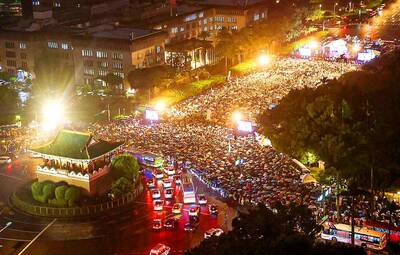The Democratic Progressive Party (DPP) was not the only party with bruises following the legislative elections yesterday, as smaller parties that had hoped to take advantage of the new "single-member district, two-vote system" also suffered a major setback.
In terms of district candidates, the Non-Partisan Solidarity Union (NPSU) fared best among the smaller parties, with Yen Ching-piao (
The NPSU's candidate in Penghu County, Lin Pin-Kuan (
disappointing
The smaller parties' performance was similarly disappointing in the competition for legislator-at-large seats, with none of the parties -- the Civic Party, the Constitutional Alliance, Third Society Party, Green Party Taiwan (GPT), Taiwan Farmers' Party, Home Party, Hakka Party and NPSU -- getting more than 1 percent, when 5 percent was required to qualify for seats.
The Home Party, which received the highest percentage of party votes among the eight smaller parties, was favored by a mere 0.79 percent of voters, while at the bottom of the list, the Constitutional Alliance, received only 0.31 percent.
The GPT, which nominated candidates in almost all of the constituencies, suffered a big setback as the most votes one of its candidates secured was little more than 3,400.
GPT Secretary-General Pan Han-shen (
"In addition, the two-vote system was not explained to voters clearly enough for them to realize that they had the option to cast their party ballot to a third, smaller party," Pan said. "The 5 percent benchmark for legislator-at-large seats is too high for new, smaller parties. Voters did not vote for us because they thought parties with only one or two legislators would have no muscle in the new legislature."
Despite not securing a seat, the party ranked quite highly among the other smaller parties in various constituencies, and Pan said he appreciated the voters' support.
The party will continue to carry on its environmental protection mission, he said.
Taiwan Farmers' Party Secretary-General Hsiao Han-chun (蕭漢俊) shared Pan's concern that the voting system gave the larger parties an edge over the smaller ones.
"This is an election where winner takes all," he said. "Without a serious reform of the system, there is no chance for the smaller parties to survive."
Third Society Party Chairman Jou Yi-cheng (
"It is also noteworthy how many people did not use their vote and dodged their civic duty," he said.
unstable
Analysts said the problem for the smaller parties stemmed from the fact that their main source of votes was an unsystematic and unstable source -- undecided voters who support neither the pan-green nor the pan-blue camp.
"When a voter supports neither camp, he or she may not vote at all, because they believe their vote counts for nothing," said Liao Da-chi (
"Although between a third and a fourth of voters aren't happy with the two major parties, many may still `vote in tears' for fear that voting for the smaller parties may disperse votes and negatively affect the pan-green or pan-blue camp," Tamkang University professor of public administration Shih Cheng-feng (
Another reason that may have contributed to the smaller parties poor showing may have been that they are relatively new to the public.
"The smaller parties may not have attracted enough voters because their `branding' is not clearly embedded enough in voters' minds," Liao said. "Unlike the New Party and Taiwan Solidarity Union, which have been around for a long time and have made known their ideology, these smaller parties are relatively new and lack a famous political figure who makes an impression."
Analysts said the 5 percent benchmark for parties to gain legislator-at-large seats was almost "mission impossible" for the smaller parties.
"The 5 percent benchmark is higher than it seems," Academia Sinica political scientist Lin Jih-wen (
"The smaller parties may have lost because of strategic sacrifices -- they only had a real chance of winning legislator-at-large seats by winning protest votes. However, 5 percent translates to almost half-a-million votes and there are not that many protest votes out there," Lin said.

The Central Weather Administration (CWA) today issued a "tsunami watch" alert after a magnitude 8.7 earthquake struck off the Kamchatka Peninsula in northeastern Russia earlier in the morning. The quake struck off the east coast of the Kamchatka Peninsula at 7:25am (Taiwan time) at a depth of about 19km, the CWA said, citing figures from the Pacific Tsunami Warning Center. The CWA's Seismological Center said preliminary assessments indicate that a tsunami could reach Taiwan's coastal areas by 1:18pm today. The CWA urged residents along the coast to stay alert and take necessary precautions as waves as high as 1m could hit the southeastern

FINAL COUNTDOWN: About 50,000 attended a pro-recall rally yesterday, while the KMT and the TPP plan to rally against the recall votes today Democracy activists, together with arts and education representatives, yesterday organized a motorcade, while thousands gathered on Ketagalan Boulevard in Taipei in the evening in support of tomorrow’s recall votes. Recall votes for 24 Chinese Nationalist Party (KMT) lawmakers and suspended Hsinchu City mayor Ann Kao (高虹安) are to be held tomorrow, while recall votes for seven other KMT lawmakers are scheduled for Aug. 23. The afternoon motorcade was led by the Spring Breeze Culture and Arts Foundation, the Tyzen Hsiao Foundation and the Friends of Lee Teng-hui Association, and was joined by delegates from the Taiwan Statebuilding Party and the Taiwan Solidarity

Instead of threatening tariffs on Taiwan-made chips, the US should try to reinforce cooperation with Taiwan on semiconductor development to take on challenges from the People’s Republic of China (PRC), a Taiwanese think tank said. The administration of US President Donald Trump has threatened to impose across-the-board import duties of 32 percent on Taiwan-made goods and levy a separate tariff on semiconductors, which Taiwan is hoping to avoid. The Research Institute for Democracy, Society, and Emerging Technology (DSET), a National Science and Technology Council think tank, said that US efforts should focus on containing China’s semiconductor rise rather than impairing Taiwan. “Without

The National Museum of Taiwan Literature is next month to hold an exhibition in Osaka, Japan, showcasing the rich and unique history of Taiwanese folklore and literature. The exhibition, which is to run from Aug. 10 to Aug. 20 at the city’s Central Public Hall, is part of the “We Taiwan” at Expo 2025 series, highlighting Taiwan’s cultural ties with the international community, National Museum of Taiwan Literature director Chen Ying-fang (陳瑩芳) said. Folklore and literature, among Taiwan’s richest cultural heritages, naturally deserve a central place in the global dialogue, Chen said. Taiwan’s folklore would be immediately apparent at the entrance of the